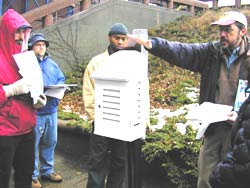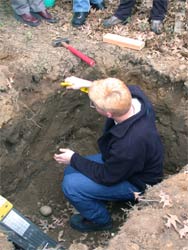Stars and STEM Stories
Queens College Science Institute Shows the Great Potential of GLOBE
New York City may be known for skyscrapers and busy streets, but K-12 students and teachers are finding and creating GLOBE study sites all over the metro area.

At an all-day Science Institute put on Jan. 9 by Queens College for the New York City Department of Education and the GLOBE-NY Metro Partnership, GLOBE teachers and students wowed teachers, science coordinators and educators from all over the New York metro area with descriptions of their GLOBE implementation ideas. For example, the GLOBE students and teacher from Louis Armstrong Middle School have transformed a trash-strewn vacant lot into a viable GLOBE study site. They cleaned up the area and, with the help of the New York City Parks Department, planted native trees and shrubs, set up their weather station and are now designing and building a pond. With help from Consolidated Edison Company of New York, which helps fund New York City GLOBE training and activities, and KeySpan Foundation, which helps fund activities and training in Nassau and Suffolk counties, the partnership is working hard to get the word out about GLOBE and to train and support teachers.

Participants at the Science Institute reported feeling excited and inspired by the demonstrations of GLOBE student inquiry activities and the data on the GLOBE web site. In fact, one education department official has signed up for a GLOBE training. Greg Borman, a K-12 science specialist from the department's Office of Math, Science and Technology, in the Division of Instructional Support, said he believes GLOBE should be a component of all New York City students' science education.
"We know how important it is for students to experience the scientific process and to engage in authentic scientific investigations," Borman said. "GLOBE provides exactly that. The students are generating their own data, which is really going to be used or analyzed by scientists. They are doing something that is important, and which may have a strong impact on environmental planning. The students see the connection between data and generating questions to explore, drawing conclusions, and making predictions. They begin to understand the need for standardization and the use of accepted protocols."
Young students put it another way: "I now see pictures in textbooks and can say, 'I saw that outside,' whereas before, the picture didn't mean anything to me," explained one Louis Armstrong middle-schooler about their GLOBE work.

At the Science Institute, Queens College GLOBE-NY Metro Partnership officials informally introduced GLOBE learning activities, including the cloud cover protocol. They also showed educators how to use the GLOBE web site for student inquiry. "We looked at one school's data and showed teachers what questions you can ask, how to use the data, how to spot students' mistakes," said Allan Ludman, a geologist at Queens College who is the partnership coordinator. "It's all part of our regular training, but we condensed it."
Teachers and science coordinators in New York are eager to find ways to fulfill state science requirements and get students motivated, Ludman said. The state has recently mandated an "exit project" for 8th grade earth science students that must be an independent study research project, using either another person's data or one's own. In addition, students must take regents exams to earn their diplomas. Teachers were so excited to see that GLOBE provides ways to prepare students for science requirements, Ludman says, because there is such a great need. Through GLOBE, students have a world of data provided by other GLOBE students, and the protocols and activities are ideal ways for students to collect their own data and develop their own projects.
"It's a relief as a teacher to have this amount of data directly related to what I'm teaching," Gregory J. Korniewicz, a GLOBE teacher at Cobble Hill High School in Brooklyn, NY, told his colleagues.
Only in operation for two years, the partnership has already trained 99 teachers, science coordinators and naturalists, from 36 high schools, one junior high school, two K-8 districts and two environmental centers. There are more than a million students in some 1,300 schools in the New York City public school system and another 150 school districts in Nassau, Suffolk and southern Westchester County. The city's parochial schools have also shown interest in incorporating GLOBE into their science curriculum. The Queens College GLOBE-NY Metro partnership is hard at work recruiting, training and supporting as many of those teachers as it can.
Linda Curtis-Bey, director of the city education department's Office of Math, Science and Technology, in the department's Division of Instructional Support, said educators are attracted to GLOBE in part because students are.
"The GLOBE Program gives students the opportunity to become active members of the worldwide community of scientists. As they work to collect and share data about their nearby school environment, they ask and answer questions, hypothesize, research, and propose possible conclusions to their inquiries," said Curtis-Bey. "They apply scientific procedures to real-life environmental issues. GLOBE participation helps students deepen their understanding of the required content and increases their ability to use science process skills. It also gives them the context to develop and apply important literacy and mathematics skills. By participating in GLOBE, students begin to see themselves as scientists and science as something that they are capable of pursuing."
Visit the new GLOBE NY Metro website at: http://www.qc.edu/qcglobe/.
27 February 2003





